Title: Superintendent of Mount Moriah Cemetery; city councilmember, mayor, real estate partner
Birthdate: November 3, 1871
Death Date: October 22, 1955
Plot Location: Section 141, Lot 19
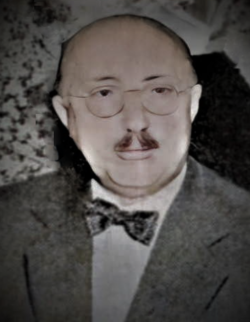
Each of the officials of Mount Moriah Cemetery Association (the organization that founded Mount Moriah and ran the cemetery until it closed) led noteworthy lives, and through their individual life stories the history of this hallowed ground is revealed. Follow the links provided to see how each life story connects with the others, and learn more about the unique place entrusted to their care.
George’s family wasn’t particularly famous but it was particularly large. He was one of eight children of his father, Horatio Pennock Connell, who was one of 13 of his father, George. Even more significant, however, was his family pedigree. Read his father’s Notable life story here and his namesake grandfather’s life story here.
Grandfather George died eight days before grandson George was born. Horatio was the secretary of the Board of Managers of the Mount Moriah Cemetery Association, which his father co-founded 17 years earlier. Horatio (nicknamed “Rash”) used that position to eventually control the daily operations and destiny of the organization.
Another George came into the picture after grandfather George died. Horatio gave his brother George the job of cemetery superintendent in the 1870s, but he died of tuberculosis in 1884. By then Horatio had been elected to a seat in the state legislature, but he also took on his brother’s job for another dozen years while grooming his son George to take over as superintendent.
Early Years
Like all of his siblings and many cousins, infant George was baptized at St. James Kingsessing (Episcopal) Church at 68th and Woodlawn, a few blocks from his home on Elmwood Ave. He grew up with four brothers, and three sisters. His obituary claims his first job was in a carpet factory working 11 hours a day for $7 a week. It obviously wasn’t because he needed the money, since there were three live-in servants on duty when he got home.
Horatio’s family lived with his mother from 1886-1890 at 60th and Kingsessing Avenue. City directories also list her at 61st and Kingsessing and 61st and Chester until just before she died in 1899. Connecting the addresses forms a square which was part of a larger parcel she owned after her husband’s death. Whether there was one home there or several isn’t known. After she died, part of it was deeded to the cemetery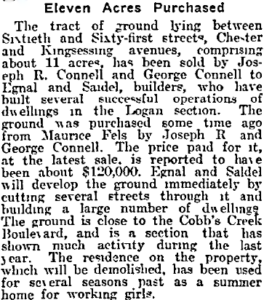 to become sections E and F. In 1915, George and his brother/real estate partner, Joseph, sold the rest of it to a homebuilder, as reported in this news article.
to become sections E and F. In 1915, George and his brother/real estate partner, Joseph, sold the rest of it to a homebuilder, as reported in this news article.
Marriage & Home Life
George married Caroline Augusta Fairman in 1892. Like George, she was the child of a prominent politician and grew up having a servant in the house. But she was just 17, so they exchanged vows in Camden, New Jersey, where a license to marry wasn’t needed. She gave birth to George Fairman Connell the following year, followed by Elizabeth in 1894.
They initially lived at his grandmother’s estate at 61st and Kingsessing. After he became cemetery superintendent in 1898 they moved to 1236 South 60th Street and had their own servant. At this point George likely started building a home on a piece of his father’s land.
An 1872 map shows Horatio owned a tract between the southwest corner of the cemetery and 65th Street and west of Chester Ave. George chose a lot that overlooked Cobbs Creek next to the cemetery’s Section 64. Since it had six bedrooms and 4200 square feet, they employed three servants after they moved in, probably around 1907. (The rest of the tract eventually became 143 row homes.)
In 1911 the city built Cobbs Creek Parkway next t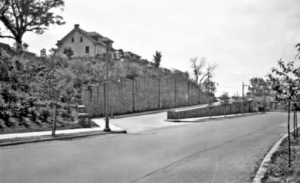 o the meandering stream, which meant purchasing a swath of cemetery property by eminent domain. The northbound on-ramp from 165th Street and its retaining wall, shown here, also gobbled up most of George’s front yard.
o the meandering stream, which meant purchasing a swath of cemetery property by eminent domain. The northbound on-ramp from 165th Street and its retaining wall, shown here, also gobbled up most of George’s front yard.
The Connell house is on the left in this 1927 photo. The only access to it was through the alley in the 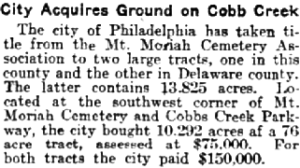 rear. He was paid $12,168 for losing two and three-quarter acres. The Mount Moriah Cemetery Association gave up about 24 acres of right-of-way that was about two-thirds of a mile long. In return they pocketed $150,000, or about $5 million in today’s dollars.
rear. He was paid $12,168 for losing two and three-quarter acres. The Mount Moriah Cemetery Association gave up about 24 acres of right-of-way that was about two-thirds of a mile long. In return they pocketed $150,000, or about $5 million in today’s dollars.
All the money in the world, however, could not compensate George for what happened next. Caroline left him for another man and took the teenage kids with her. She married Redmond Conyngham, a stock broker, in Manhattan in October of 1911. They honeymooned in Bermuda and lived on Staten Island. George’s daughter, Elizabeth, married in 1915, while son George joined the National Guard in 1916 and made the military his career.
Work, Land, & Politics
George never re-married, but busied himself with his work at the cemetery because the “Alpha Sections,” sections A-G were now being marketed. On the side, he bought and sold real estate. There was that strip of land on the alley next to his house, plus his mother’s properties. In 1914 he and his brother Joe sold a large tract in Atlantic City, with 300 feet of Boardwalk frontage, for over $300,000. Later that year he and Joe created the Hillcrest Lawns Realty Co. to sell lots in Haverford Township, Delaware County. The Connells knew how to turn land into wealth.
George had an even greater interest in local politics. He was first elected to the city’s Common Council in 1913, then to the Select Council in 1915. By 1919 the city created just one City Council, of which George was a member for the next 20 years, never losing an election.
He served as president of City Council starting in January, 1938. In August of 1939 the current mayor resigned for health reasons, so the job of Acting Mayor fell to George until the new mayor took over in January. The incoming mayor immediately appointed him as Director of Public Welfare, where he served until retiring in 1943.
His brief legacy as mayor was noteworthy for the passage of a wage tax of 1.5% on earned incomes from both city residents and commuters. After withstanding a court challenge, that tax remains today as the city’s largest source of revenue.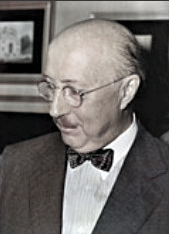
George had a stroke the year he retired and spent his last 12 years in a convalescent home. His daughter had just died in 1942; his estranged son, twice divorced, died when his mobile home in Oregon caught fire. George invited his sister Ann’s family to occupy his Cobbs Creek home. She was the only sibling to outlive him, but only until 1961. Perhaps she was the last Connell on the board of directors.
George’s role at Mount Moriah lost much of its luster over the years as he put more of his energy into the workings of City Council. He held the post of superintendent until his father, “Rash,” died in 1927, assuming his title of secretary/treasurer for the board. Cemetery records say he held that position until his death. Who succeeded him in that position, and who was on the board at that time isn’t known.
The Great Transition
There was no one with the Connell name who wanted to take the baton from him. Fortunately a loyal cousin of George who worked at the cemetery was a worthy candidate.
Horatio’s wife, Ann Laycock Connell had a sister, Elizabeth Laycock, who married Charles Jones. He happened to be a stonecutter, just like his wife’s father, William. Not coincidentally, William Laycock was also on the board of Mount Moriah for many years. Outside of their business relationship, the families were all long-standing members of the same church, St. James Kingsessing at 68th and Woodland.
The sisters had a close relationship. Elizabeth even named one of her sons Horatio Connell Jones in honor of her brother-in-law. In a surprising plot twist, this wasn’t the nephew that joined the family business; it was his brother, James Woods Jones. (Horatio Connell Jones became a doctor.)
This nephew, James, was a 20-year-old house painter when he married Mary Ellen Long in August of 1900. It was just 14 days after his mother Elizabeth died and 13 months before his father Charles died. “Uncle Rash” took him under his wing and asked cousin George to give him a job. The 1902 city directory lists him as a laborer there. His first son was named James, a daughter named Maude, and their second son was Horatio Connell Jones, reflecting his gratitude to his uncle.
By 1915 James was the foreman, and on the 1920 census he was “cemetery policeman.” Sometime between 1927-29 George gave him the responsibility of running things as superintendent. He not only lived for his work but he lived at his work. He and his wife may have lived in the apartment above the 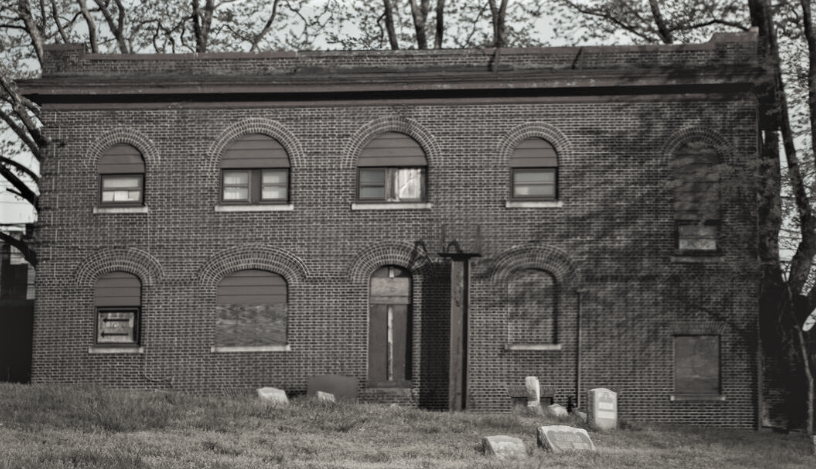 cemetery office, shown here, or in the residence on the right side of the gatehouse building.
cemetery office, shown here, or in the residence on the right side of the gatehouse building.
It was a brief tenure, a little more than 12 years, but with guidance from George, who was now secretary/treasurer, he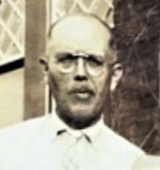 steered the business through the Great Depression. James was paid well, and he learned from his cousin George about investing in real estate. By the time he died in 1941 he had also taught his son, also called “Rash,” to buy and sell land. That was how the Jones family gained a personal fortune, even as the cemetery would slowly begin to lose its luster as a viable business. Mary Ellen continued to live above the office until she died in 1950.
steered the business through the Great Depression. James was paid well, and he learned from his cousin George about investing in real estate. By the time he died in 1941 he had also taught his son, also called “Rash,” to buy and sell land. That was how the Jones family gained a personal fortune, even as the cemetery would slowly begin to lose its luster as a viable business. Mary Ellen continued to live above the office until she died in 1950.
Rash succeeded his father and called himself the manager. He was followed by his son, Horatio Jr, who died in 2004 with no heir apparent or plan of succession. Of all the bosses in the cemetery’s history, only Junior chose to be buried elsewhere.
Coronary artery disease is what took James Jones’ life in 1941. Was his successor already arranged or approved by George? What relationship did George have with his successor before George’s stroke two years later? The answers are unknown, but the story of the cemetery continues as does the life story of Horatio Connell Jones Sr., which is found here.

Support the Friends of Mount Moriah
Help us in our mission to restore and maintain the beautiful Mount Moriah Cemetery by donating to our cause or volunteering at one of our clean-up events.

